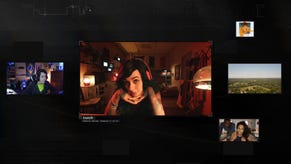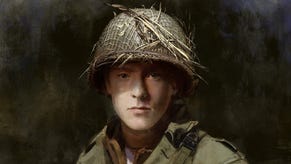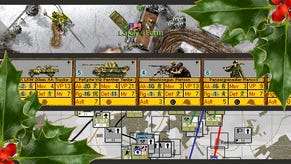The Flare Path: Reductions Reveille
Simulation & wargame blather
Wakey-wakey, rise and spend! Jackie is blowing her utility trumpet because she wants the world to know that three old wargames have just had their prices slashed. As conveying detailed sale information with valveless brass instruments is notoriously tricky, it will be left up to Jackie's assistant Jean (Out of picture. Armed with a Glockenspiel 17.) to explain that the games in question are John Tiller's Battleground Civil War, Forge of Freedom: The American Civil War and The Great Battles Collector's Edition.
At $20/£16.80 a piece, the two American Civil War antiques are still going to seem dear to many. You need to have pressed your snotty proboscis up against the plate-glass window of Matrix's pricey uptown boutique on a few occasions to realise that this new weekly deal initiative actually qualifies as a fairly bold price experiment by the world's biggest PC wargames publisher.
Hex wargaming at its most traditional and generously provisioned, John Tiller's BCW is in fact a compilation of five old Talonsoft 'Battleground' titles - Gettysburg, Shiloh, Antietam, Bull Run and Chickamauga. These grizzled-and-sometimes-gaudy tactical TBSs might lack some of the realism and campaign enhancements of their spiritual successors, the HPS ACW series, but in terms of scope, accessibility, and value, it's hard to know where you'd go to find a better Blue vs Grey deal.
Younger, fresher, and far more ambitious, Forge of Freedom is exactly the sort of game that deserves to be given a second chance. I'm not quite sure how I managed to miss this dual-layered oddity the first time round (2006). Maybe I was put off by harsh forum talk of overwhelming complexity and an unwieldy interface. While it's true that FoF would - like so many wargames - benefit from an interactive tutorial and more extensive tooltips, it's far from the grogs-only ballbreaker it's sometimes painted as. Put in a couple of hours with the well-written 250-page manual, digest tips threads like this one, and dial-down complexity and difficulty options before commencing your first campaign, and Western Civilization Software's opus may actually end-up feeling more logical, more transparent, during those crucial early play sessions than equivalent AGEOD or Paradox offerings.
When wargame devs attempt to combine the tactical and the strategic, all too often one of the two elements ends up feeling scrawny or ill-conceived. Not here. When army flags meet on FoF's unzoomable-but-attractive strat map they sometimes (as in AGEOD games, you can, by setting stances, encourage evasion) trigger a scrap. Those scraps can be played out using one of three mechanisms: a Total-War style auto-resolve system (crude but super-swift), a grid-based 'Quick Combat' mode (stylised yet compelling) or, the game's impressive secret weapon, a full-blown John Tiller-esque clash on a hex battlefield that is both randomly generated and region inspired.
With serviceable AI and influential terrain, weather, and generals on the tac level, and well thought-out political, diplomatic, attrition and city development shorthand on the strat level, you really do feel like you're getting two high-quality wargames in one. For the sake of brassic battle gamers everywhere (especially in the UK where Matrix's VAT policy and sometimes strange exchange rate calculations frequently lead to unfairness) I wish the price was nearer £10 than £20, but still, this is an encouraging move from Slitherine/Matrix.
Proving old wargames don't have to wear double-figure price tags, good old Good Old Games released the old-as-the-Seven-Hills Great Battles Collector's Edition for an irresistible $5.99/£3.85 this week.
Coded in 1997 and 1998 by the short-lived Erudite Software, Great Battles: Hannibal, Alexander, and Caesar, wear their board game roots proudly. Cramped battlefields and a rather flimsy campaign system, don't make the 33 included engagements significantly less engaging, or features like the ingenious leader activation approach any less brilliant.
As you'd hope from a series that put likenesses of three of antiquity's sharpest military minds on its boxlids, leaders really do turn battles. Their stats determine when in a turn they act, how many orders they can issue, and, crucially, how likely they are to get 'momentum' - a bonus extra phase, or even, pair of phases, at the end of a standard activation. It sounds gamey but it actually works extremely well, breaking up combat rhythms already rendered unpredictable by the leader initiative system.
Overlook a reluctance to withdraw badly mauled formations (that may, in certain circumstances, be entirely historical) and the AI plays a pretty good game. Automatic reaction fire and cavalry evasion, together with mutual strength/cohesion corrosion during close-combat, mean an inactive force isn't a helpless force.
The terrain art hasn't aged well but the soldier sprites and sounds still have undeniable charm. I could watch my trumpeting war-jumbos trample wolf-helmed velites all day. A pity then, all of my pachyderms are usually dead by turn 3 in most battles.
The Flare Path Foxer
Thanks to the logical litheness of phlebas, Dozer, mrpier, Grible and pertusaria, the Upper Bumhope church fete now has a workable Warrior Cavalcade plan. In fact, it has five. Last year John headed the procession followed by Roger, Beth, Gary P, Peter, Ivan, Timo, Gary J, Paula and Sajid. This year, in order to maximise the distance between the fractious Garys, the troops will probably troop past like this:
- Gary P
- John
- Beth
- Paula
- Roger
- Peter
- Timo
- Sajid
- Ivan
- Gary J
All those that provided practical plans get a pot of Miss Sankey's famous greengage, ginger, & gin jam, and, assuming they can make it to Upper Bumhope on May 18th, a free go on Mr Hibbert's always-popular Bowl-For-A-Pig stall.
Miss Sankey's 'Triple G' jam has claimed many victims over the years. Among the first to underestimate its potency were a trio of Ordnance Survey cartographers that visited the village in 1938. After a swift cream tea in the Dick Turpin, the group attempted to map the parish. A few hours later one was found wandering on Windmill Hill dressed in nothing but a daisy-chain necklace; another was fished out of the Bum, more dead than alive; the third was never seen again.
OS Rambler map no.43 (the 1939 edition) contains evidence of that extraordinary day. In grid square 5237 there are twelve major mistakes that can surely only be explained by preserve-induced inebriation. Identify the carto-cockups and, if you care to, speculate on the fate of the third OS man, to claim a Flare Path flair point made from highly polished theodolite.




















